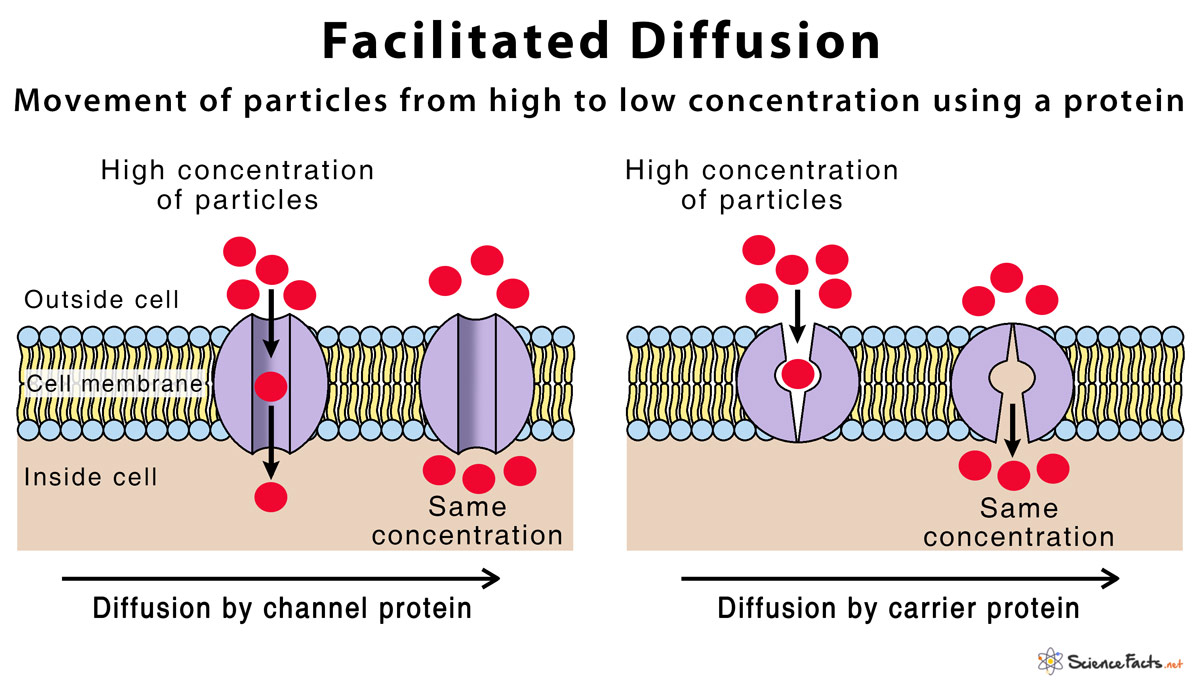Facilitated Diffusion
What is Facilitated Diffusion
It is a type of diffusion occurring in living cells where the molecules move from the region of their higher concentration to the region of lower concentration guided by a helper protein molecule. The helper protein is usually an integral membrane protein that forms a pore or channel in the cell membrane. Facilitated diffusion is a passive transport mechanism and thus requires no energy expenditure by the cell.
What Happens During the Process of Facilitated Diffusion
Facilitated diffusion is a spontaneous process in which charged ions or molecules are transported across the lipid-based cell membrane via a carrier transmembrane protein molecule. It is a selective process, which means the membrane allows only selective molecules and ions to pass through it, denying passage to others.
Biological Example of Facilitated Diffusion
- Transport of glucose across the cell membrane with the help of carrier proteins called glucose transporter
- Passage of water across the lipid bilayer of the cell membrane using specific transmembrane channel proteins called aquaporins
- Selective transport of ions and solutes in and out of the cell using membrane proteins called ion channels
What are the Characteristics of Facilitated Diffusion
- Occurs due to the random motion of molecules (Brownian motion)
- Requires a biological membrane for transport
- Requires a carrier protein, thus also known as carrier-mediated diffusion
- Does not require energy expenditure and use of high energy phosphate molecules – ATP (Adenosine triphosphate) or GTP (Guanosine-5′-triphosphate) hydrolysis and thus it is a type of passive transport mechanism
- Transports large charged ions, small molecules, proteins, and other solutes
- It is a selective process thus allowing the passage of selective molecules across the membrane
What Factors Affect Facilitated Diffusion
Any factors affecting the motion of molecules will limit the rate of diffusion, these include:
- Temperature – Higher temperature increases the random motion of molecules and thus higher is the rate of diffusion
- Concentration – Higher the concentration gradient between the regions undergoing diffusion, more is the rate of diffusion
- Distance – The rate of diffusion is faster in smaller distances
- Size of the molecules – Smaller the size of the molecule, faster is the rate of diffusion and vice versa.
Importance of Facilitated Diffusion in Plant and Animal Cells: When is it Necessary
Helping in the transport of some of the essential large biomolecule such as glucose, amino acids, and nucleic acids, and charged ions like sodium, potassium, and calcium. It also helps in the bulk transport of water molecules within the cell that cannot be passed using simple diffusion.
What are the Different Types of Facilitated Diffusion
There are two different types of facilitated diffusion based on the structure of the transmembrane protein present in the plasma membrane –
1) Mediated by Channel Proteins – Span the membrane and create a channel through them to transport molecules or ions in and out of the cell
2) Mediated by Carrier Proteins – Carry the molecules or ions across the membrane by changing their shape after binding
FAQs
Ans. Facilitated diffusion assists in the transport of large, polar molecules and charged ions across the cell membrane using a helper protein molecule, whereas ordinary diffusion allows free passage to small, non-polar molecules, such as oxygen and carbon dioxide in and out of the cell.
Ans. Facilitated diffusion refers to the diffusion of many different substances, including both solvent and solute molecules across the cell membrane. In contrast, osmosis refers only to the transport of water in and out of the cell.
Ans. Facilitated diffusion of substances requires no energy expenditure, whereas active transport uses cellular energy for transporting substances across the cell membrane.
Ans. The main similarity between facilitated diffusion and active transport is that both require certain carrier protein molecules for carrying out the transport.
Ans. Facilitated diffusion is a passive transport mechanism, whereas the sodium-potassium pump is an active transport mechanism.
-
References
Article was last reviewed on Thursday, February 2, 2023




